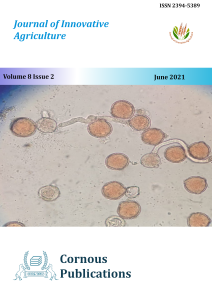
Journal of Innovative Agriculture
Peer Reviewed Open Access Journal
ISSN: 2394-5389 NAAS: 4.05
Submit Manuscript
Peer Reviewed Open Access Journal
ISSN: 2394-5389 NAAS: 4.05
Submit ManuscriptOPEN ACCESS | Published on : 30-Jun-2021 | Doi : 10.37446/jinagri/rsa/8.2.2021.1-8 | Pages : 1-8
OPEN ACCESS | Published on : 30-Jun-2021 | Doi : 10.37446/jinagri/rsa/8.2.2021.9-16 | Pages : 9-16
OPEN ACCESS | Published on : 30-Jun-2021 | Doi : 10.37446/jinagri/rsa/8.2.2021.17-21 | Pages : 17-21
OPEN ACCESS | Published on : 30-Jun-2021 | Doi : 10.37446/jinagri/rsa/8.2.2021.22-28 | Pages : 22-28
OPEN ACCESS | Published on : 30-Jun-2021 | Doi : 10.37446/jinagri/rsa/8.2.2021.29-33 | Pages : 29-33
OPEN ACCESS | Published on : 30-Jun-2021 | Doi : 10.37446/jinagri/rsa/8.2.2021.34-38 | Pages : 34-38
OPEN ACCESS | Published on : 30-Jun-2021 | Doi : 10.37446/jinagri/rsa/8.2.2021.39-46 | Pages : 39-46
OPEN ACCESS | Published on : 30-Jun-2022 | Doi : 10.37446/jinagri/rsa/8.2.2021.47-51 | Pages : 47-51
OPEN ACCESS | Published on : 30-Jun-2021 | Doi : 10.37446/jinagri/rsa/8.2.2021.52-58 | Pages : 52-58
OPEN ACCESS | Published on : 30-Jun-2021 | Doi : 10.37446/jinagri/rsa/8.2.2021.59-66 | Pages : 59-66
OPEN ACCESS | Published on : 30-Jun-2021 | Doi : 10.37446/jinagri/rsa/8.2.2021.67-74 | Pages : 67-74
